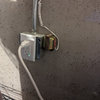12V DC Keypad to feed an 16-24V AC electric door strike?
johncritter
14 years ago
Related Stories

LIFEHow to Prepare for and Live With a Power Outage
When electricity loss puts food, water and heat in jeopardy, don't be in the dark about how to stay as safe and comfortable as possible
Full Story
CURB APPEAL77 Front Doors to Welcome You Home
Crossing the threshold is an event with these doors in a gamut of styles
Full Story
KITCHEN DESIGNSee-Through Refrigerators Dare to Go Bare
Glass-front fridge doors put your food and drinks on display, for better or worse. See the benefits and disadvantages
Full Story
MOST POPULAR11 Nominees for the ‘She Shed’ Hall of Fame
These special sanctuaries let busy women get away from it all without leaving the backyard
Full Story
MODERN HOMESHouzz Tour: 800-Year-Old Walls, Modern Interiors in Provence
Old architecture and new additions mix beautifully in a luxurious renovated vacation home
Full Story
GREEN BUILDINGLet’s Clear Up Some Confusion About Solar Panels
Different panel types do different things. If you want solar energy for your home, get the basics here first
Full Story
LIGHTINGThe Lowdown on High-Efficiency LED Lighting
Learn about LED tapes, ropes, pucks and more to create a flexible and energy-efficient lighting design that looks great
Full Story
MOST POPULARHow to Add a Backyard Shed for Storage or Living
Need a home office, a playspace or extra room for your stuff? Learn about off-the-shelf, prefab and custom sheds
Full Story
GREAT HOME PROJECTSHow to Give Your Driveway and Front Walk More Curb Appeal
Prevent injuries and tire damage while making a great first impression by replacing or repairing front paths
Full Story
GREEN BUILDINGHouzz Tour: Going Completely Off the Grid in Nova Scotia
Powered by sunshine and built with salvaged materials, this Canadian home is an experiment for green building practices
Full Story








pharkus
steve_fl
Related Professionals
Grafton Electricians · Augusta General Contractors · Monroe General Contractors · Ravenna General Contractors · Saint George General Contractors · Lakeville Solar Energy Systems · Orinda Solar Energy Systems · Saratoga Solar Energy Systems · Greatwood Home Automation & Home Media · Inglewood Home Automation & Home Media · La Crescenta-Montrose Home Automation & Home Media · Pittsburgh Home Automation & Home Media · Ponte Vedra Beach Home Automation & Home Media · Saint Petersburg Home Automation & Home Media · San Bruno Home Automation & Home Mediapharkus
johncritterOriginal Author
kensnh
johncritterOriginal Author
pharkus
johncritterOriginal Author
pharkus
kensnh